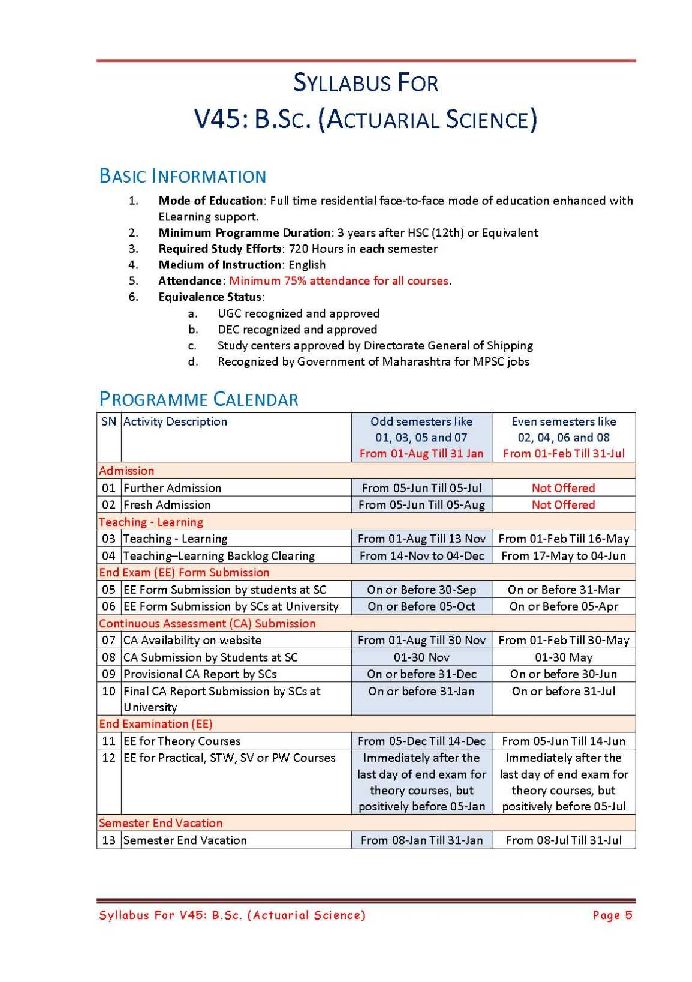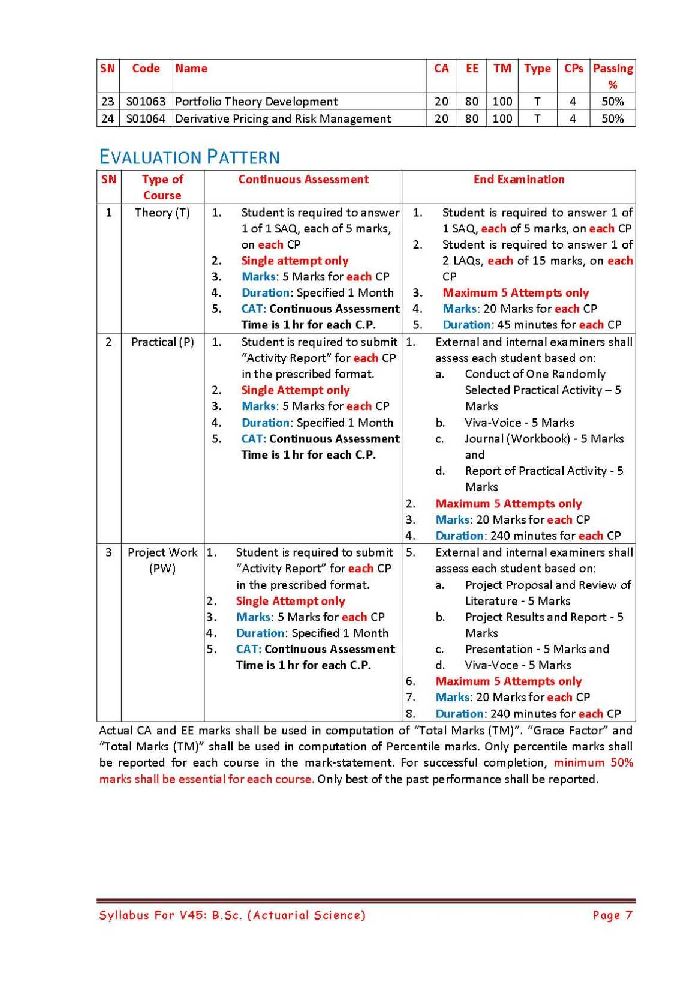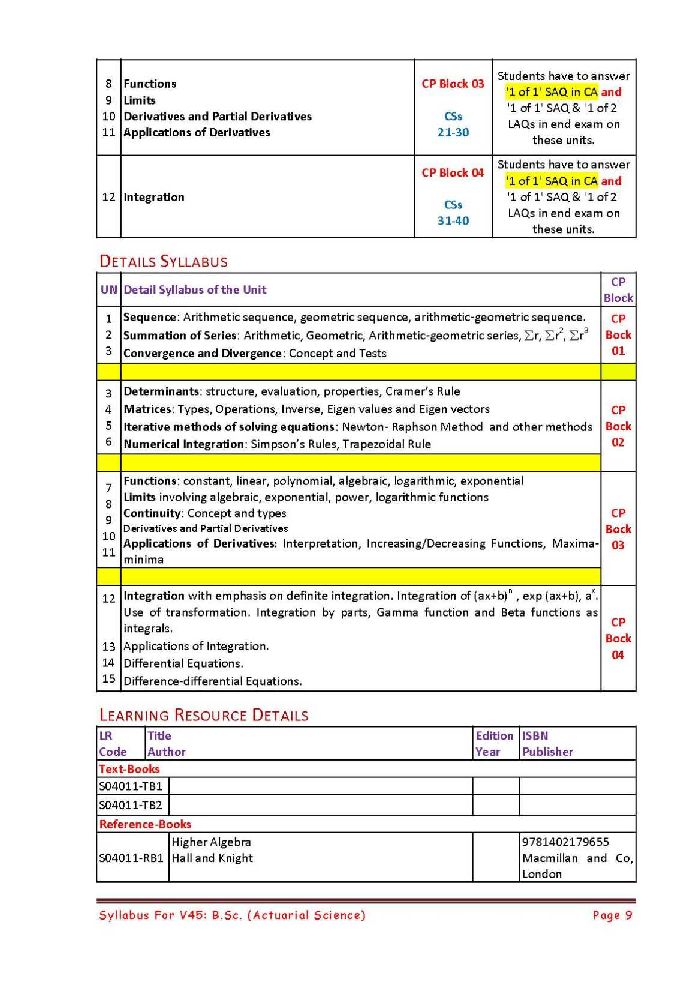|
#1
| |||
| |||
|
I am going to participate in Actuarial Common Entrance Test, so need exam syllabus, can you please provide here? B.Sc. Actuarial Science or Bachelor of Science in Actuarial Science is an undergraduate Actuarial Science course. Bachelor of Science in Actuarial Science is three years degree course but its duration may fluctuate from place to place. The syllabus for the course is divided into six semesters. The degree course is an important and valuable one that opens many career scopes along with further higher studies. Duration: 3 Years Level: Graduation Type: Degree Eligibility: 10+2 or Equivalent You are asking for the B.Sc. Actuarial Science syllabus. Here I am uploading a file that contains the B.Sc. Actuarial Science syllabus. You can download the B.Sc. Actuarial Science syllabus from here. This is as follows: B.Sc. Actuarial Science syllabus      Last edited by Aakashd; February 26th, 2020 at 05:33 PM. |
|
#2
| ||||
| ||||
|
Actuarial Common Entrance Test is conducted by Institute of Actuaries of India in online mode across the country. The exam comprises of 2 papers such as Mathematics and Statistics. There will be a total of 55 multiple choice objective type questions in the exam. These 25 questions carry one mark each, Next 25 questions carry 2 marks each. Last 5 questions carry 5 marks each. Duration for exam is 2 hours to answer all questions. Syllabus; The FAC course The Foundation Course consists of a set of eight chapters of notes covering the following ideas: Chapter 1 Notation Chapter 2 Numerical Methods I Chapter 3 Mathematical constants and standard functions Chapter 4 Algebra Chapter 5 Numerical Methods II Chapter 6 Differentiation Chapter 7 Integration Chapter 8 Vectors and matrices We recommend that you work through the sections that you are unsure of, completing the questions that are given. If you need further practice, there is a Question and Answer Bank and a Summary Test. These both cover material from all the chapters. Section 5 of this study guide gives you an index of the topics that are covered in order to identify quickly which chapters you need to look at. When you are working through the Core Technical subjects you can continue to use this course as a reference document if you come across areas of mathematics which you are still unhappy about. 1.1 Syllabus This syllabus has been written to help in designing introductory tuition material for new students. It is not an official syllabus of the profession. The topics are all required within the Core Technical subjects. From past experience we know that some students can be a little rusty on mathematical techniques so we have designed a course to help students brush up on their knowledge. Unlike other actuarial subjects, there is no official syllabus, Core Reading or formal examination. (a) Mathematical Notation, Terminology and Methods (a)(i) Be familiar with standard mathematical notation and terminology, so as to be able to understand statements such as the following: 1. , , , , 3: n n n a b c n n a b c ∃ ∈ ≥ + = / 2. 2 ( ,0], {0} x x + ∀ ∈ −∞ ∈ ∪ 3. { : 1,2,3, } x x = = … 4. x x ∈∅ ⇒ = −163 5. “Zero is a non-negative integer; πis a positive real number.” 6. “ f x ( ) vanishes as x tends to − ∞ , is not defined when x = 0 , but takes positive values for sufficiently large x .” (a)(ii) Know the representations and names of the letters of the Greek alphabet that are commonly used in mathematical, statistical and actuarial work, including in particular, the following letters: – lower-case: α, β, γ, δ, ε, θ, κ, λ, μ, ν, π, ρ, σ, τ, φ, χ, ψ, ω – upper-case: Γ, Δ, Θ, Π, Σ, Φ, Ω (a)(iii) Understand the meaning of the following commonly used conventions: – round brackets used to denote negative currency amounts, – K and m used as abbreviations for “thousand” and “million” – Δ used to denote the signed magnitude of a change in a quantity, – “iff” used as an abbreviation for “if and only if”. Page 3 of 8 ACET - January 2012 Examinations Institute of Actuaries of India (a)(iv) Understand the concept of a mathematical proof and the meaning of “necessary”, “sufficient” and “necessary and sufficient” as they are used in mathematical derivations. (a)(v) Prove a result using the method of mathematical induction. (b) Numerical methods (b)(i) Evaluate numerical expressions using an electronic calculator with the following features: arithmetic functions ( + − × ÷ ), powers ( y x ) and roots ( y x ), exponential ( ex ) and natural log ( ln x ) functions. (The following features are also useful but not essential: factorial function ( n!), combinations ( n r C ), hyperbolic tangent function and its inverse ( tanh x and tanh−1 x ), fraction mode, at least one memory and an “undo” facility. Statistical and financial functions are not required.) Students should be able to make efficient use of memories, brackets and/or the calculator stack. (b)(ii) Estimate the numerical value of expressions without using a calculator and apply reasonableness tests to check the result of a calculation. (b)(iii) Quote answers to a specified or appropriate number of decimal places or significant figures (using the British convention for representing numbers), and be able to assess the likely accuracy of the result of a calculation that is based on rounded or approximated data values. (b)(iv) Be able to carry out consistent calculations using a convenient multiple of a standard unit (eg working in terms of £000s). (b)(v) Express answers, where appropriate, in the form of a percentage (%) or as an amount per mil (‰). (b)(vi) Calculate the absolute change, the proportionate change or the percentage change in a quantity (using the correct denominator and sign, where appropriate) and understand why changes in quantities that are naturally expressed as percentages, such as interest rates, are often specified in terms of “basis points”. (b)(vii) Calculate the absolute error, the proportionate error or the percentage error in comparisons involving “actual” versus “expected” values or approximate versus accurate values (using the correct denominator and sign, where appropriate). (b)(viii)Determine the units of measurement (dimensions) of a quantity and understand the advantages of using dimensionless quantities in certain situations. (b)(ix) Use linear interpolation to find an approximate value for a function or the argument of a function when the value of the function is known at two neighbouring points. (b)(x) Apply simple iterative methods, such as the bisection method or the Newton- Raphson method, to solve non-linear equations. (b)(xi) Carry out simple calculations involving vectors, including the use of row/column vectors and unit vectors, addition and subtraction of vectors, multiplication of a vector by a scalar, scalar multiplication (“dot product”) of two vectors, determining the magnitude and direction of a vector, finding the angle between two vectors and understanding the concept of orthogonality. (b)(xii) Carry out calculations involving matrices, including transposition of a matrix, addition and subtraction of matrices, multiplication of a matrix by a scalar, multiplication of two appropriately sized matrices, calculating the determinant of a matrix, calculating and understanding the geometrical interpretation of eigenvectors and eigenvalues, finding the inverse of a 2 2 × matrix and using matrices to solve systems of simultaneous linear equations. (c) Mathematical Constants and Standard Functions (c)(i) Be familiar with the mathematical constants π and e . (c)(ii) Understand and apply the definitions and basic properties of the functions x n (where n may be negative or fractional), cx (where c is a positive constant), exp( ) x [= ex ], and ln x [ = loge x or log x ]. (c)(iii) Sketch graphs of simple functions involving the basic functions in (c)(ii) by identifying key points, identifying and classifying turning points, considering the sign and gradient, and analysing the behaviour near 0, 1, ± ∞ or other critical values. (c)(iv) Simplify and evaluate expressions involving the functions x (absolute value), [ ] x (integer part), max( ) … and min( ) … , and understand the concept of a bounded function. [The notation ( ) x − + 100 will also be used as an abbreviation for max( , ) x −100 0 .] (c)(v) Simplify and evaluate expressions involving the factorial function n! for nonnegative integer values of the argument and the gamma function Γ( ) x for positive integer and half-integer values of the argument. (c)(vi) Understand the concept of a complex number and be able to simplify expressions involving i = −1 , including calculating the complex conjugate. (c)(vii) Calculate the modulus and argument of a complex number, represent a complex number on an Argand diagram or in polar form ( z rei = θ). (c)(viii) Apply Euler’s formula e i i θ θ θ = + cos sin and use the basic properties of the sine and cosine functions to simplify expressions involving complex numbers, including determining the real and imaginary parts of an expression. (c)(ix) Understand the correspondence between the factors of a polynomial expression and the roots of a polynomial equation and appreciate that a polynomial equation of degree n with real coefficients will, in general, have n roots consisting of conjugate pairs and/or real values (d) Algebra (d)(i) Manipulate algebraic expressions involving powers, logs, polynomials and fractions. (d)(ii) Solve simple equations, including simultaneous equations (not necessarily linear) by rearrangement, substitution, cancellation, expansion and factorisation. (d)(iii) Solve an equation that can be expressed as a quadratic equation (with real roots) by factorisation, by “completing the square” or by applying the quadratic formula, and identify which of the roots is appropriate in a particular context. (d)(iv) Solve inequalities (“inequations”) in simple cases and understand the concept of a “strict” or “weak” inequality. (d)(v) State and apply the arithmetic-geometric mean inequality, and know the conditions under which equality holds. (d)(vi) Understand and apply the Σ and Π notation for sums and products, including sums over sets (eg Σ i≥0 ) and repeated sums. (d)(vii) Calculate the sum of a series involving finite arithmetic or geometric progressions or non-terminating geometric progressions using the formulae: and be able to determine when a non-terminating geometric series converges. (d)(viii) Apply the formulae: k nn (d)(ix) Solve simple first or second order difference equations (recurrence relations), including applying boundary conditions, by inspection or by means of an auxiliary equation. (d)(x) Recognise and apply the binomial expansion of expressions of the form ( ) a b n + where n is a positive integer, and ( ) 1 + x p for any real value of p and, in the latter case, determine when the series converges. (e) Calculus (e)(i) Understand the concept of a limit (including limits taken from one side) and evaluate limits in simple cases using standard mathematical notation, including the use of “order” notation O x ( ) and o x ( ), and the sup/ lub and inf / glb functions (considered as generalisations of max and min ). (e)(ii) Understand the meaning of a derivative as the rate of change of a function when its argument is varied (in particular, for functions dependent on t , the time measured from a specified reference point), including the interpretation of a derivative as the gradient of a graph. (e)(iii) Differentiate the standard functions x n , cx , ex and ln x . (e)(iv) Evaluate derivatives of sums, products (using the product rule), quotients (using the quotient rule) and “functions of a function” (using the chain rule). (e)(v) Understand the concept of a higher-order (repeated) derivative and be familiar with the mathematical notation used to denote such quantities. (e)(vi) Use differentiation to find the maximum or minimum value of a function over a specified range (including the application of a monotone function, such as the natural log function, to simplify the calculation) and determine the nature of stationary points. (e)(vii) Understand the meaning of a partial derivative and how to express a partial derivative in standard mathematical notation, and be able to evaluate partial derivatives in simple cases. Find extrema of functions of two variables. (e)(viii)Use the method of Lagrangian multipliers. (e)(ix)Understand the meaning of an indefinite integral as the anti-derivative of a function and the meaning of a definite integral as the limit of a sum of infinitesimal elements, including the interpretation of a definite integral as the area under a graph. (e)(x) Integrate the standard functions x n , cx and ex . (e)(xi) Evaluate indefinite and definite integrals by inspection, by identifying and applying an appropriate substitution, by integration by parts, by using simple partial fractions or by a combination of these methods. (e)(xii) Determine when a definite integral converges. (e)(xiii)Understand the meaning of a multiple integral and how to express a multiple integral in standard mathematical notation, and be able to evaluate a double integral as a repeated integral in simple cases, including determining the correct limits of integration. Swap the order of integration. (e)(xiv) Apply the trapezium rule to find the approximate value of an integral. (e)(xv)State and apply Taylor series and Maclaurin series in their simplest form, including using these to determine the approximate change in a function when the argument is varied by a small amount. (Knowledge of the error terms is not required.) (e)(xvi) Recognise and apply the Taylor series expansions for ex and ln( ) 1+ x and, in the latter case, determine when the series converges. (e)(xvii)Solve simple ordinary first and second order differential equations, including applying boundary conditions, by direct integration (which may involve a function of the dependent variable), by separation of variables or by applying an integrating factor. (e)(xvii)Differentiate expressions involving definite integrals with respect to a parameter, including cases where the limits of integration are functions of the parameter. (g) General (g)(i) Be familiar with the currency systems of the United Kingdom (pounds and pence sterling), the United States (dollars and cents), the European monetary system (Euros and cents) and other major economies, and be able to interpret and write down currency amounts using these systems. (g)(ii) Be familiar with the Gregorian calendar, including determining when a specified year is a leap year, the concepts of calendar years, quarters and tax years, and the abbreviations commonly used to represent dates in the United Kingdom, Europe and the United States. (g)(iii) Understand the distinction between “expression”/“equation”/“formula” and “term”/“factor”. (g)(iv) Understand the meaning of the words “gross”, and “net”. (g)(v) Be able to spell the following words correctly: actuarial, appropriately, basically, benefit, benefiting, bias(s)ed, calendar, cancelled, commission, consensus, correlation, cyclically, deferred, definitely, formatted, fulfil, gauge, hierarchy, immediately, independence, instalment (British spelling), lose, loose, millennium, necessary, occasion, occurred/occurring, offered, orthogonal, paid, particularly, pensioner, precede, proceed, receive, referred, relief, seize, separate, similarly, specifically, supersede, targeted, theorem, until, yield. (g)(vi) Be able to determine the correct member of word pairs according to context: eg affect/effect, principal/principle, dependant/dependent. (g)(vii) Be able to distinguish between the singular and plural forms of words of Latin or Greek origin, including the following: criterion/criteria, formula/formulae, analysis/analyses. [The word “data” may be treated as singular or plural, according to the preferences of individual authors/speakers.] (g)(viii)Be familiar with commonly used Latin expressions and abbreviations such as “per annum”, “vice versa”, “status quo”, “pro rata”, “ie”, “eg”, “cf”, “sic” and “stet”.
__________________ Answered By StudyChaCha Member |
 |
| |